Study and Investigation on 5G Technology: A Systematic Review
Abstract
:1. Introduction
1.1. Evolution from 1G to 5G
1.2. Key Contributions
- This survey focused on the recent trends and development in the era of 5G and novel contributions by the researcher community and discussed technical details on essential aspects of the 5G advancement.
- In this paper, the evolution of the mobile network from 1G to 5G is presented. In addition, the growth of mobile communication under different attributes is also discussed.
- This paper covers the emerging applications and research groups working on 5G & different research areas in 5G wireless communication network with a descriptive taxonomy.
- This survey discusses the current vision of the 5G networks, advantages, applications, key technologies, and key features. Furthermore, machine learning prospects are also explored with the emerging requirements in the 5G era. The article also focused on technical aspects of 5G IoT Based approaches and optimization techniques for 5G.
- we provide an extensive overview and recent advancement of emerging technologies of 5G mobile network, namely, MIMO, Non-Orthogonal Multiple Access (NOMA), mmWave, Internet of Things (IoT), Machine Learning (ML), and optimization. Also, a technical summary is discussed by highlighting the context of current approaches and corresponding challenges.
- Security challenges and considerations while developing 5G technology are discussed.
- Finally, the paper concludes with the future directives.
2. Existing Surveys and Their Applicability
2.1. Limitations of Existing Surveys
2.2. Article Organization
3. Preliminary Section
3.1. Emerging 5G Paradigms and Its Features
3.2. Commercial Service Providers of 5G
3.3. 5G Research Groups
3.4. 5G Applications
- High-speed mobile network: 5G is an advancement on all the previous mobile network technologies, which offers very high speed downloading speeds 0 of up to 10 to 20 Gbps. The 5G wireless network works as a fiber optic internet connection. 5G is different from all the conventional mobile transmission technologies, and it offers both voice and high-speed data connectivity efficiently. 5G offers very low latency communication of less than a millisecond, useful for autonomous driving and mission-critical applications. 5G will use millimeter waves for data transmission, providing higher bandwidth and a massive data rate than lower LTE bands. As 5 Gis a fast mobile network technology, it will enable virtual access to high processing power and secure and safe access to cloud services and enterprise applications. Small cell is one of the best features of 5G, which brings lots of advantages like high coverage, high-speed data transfer, power saving, easy and fast cloud access, etc. [40].
- Entertainment and multimedia: In one analysis in 2015, it was found that more than 50 percent of mobile internet traffic was used for video downloading. This trend will surely increase in the future, which will make video streaming more common. 5G will offer High-speed streaming of 4K videos with crystal clear audio, and it will make a high definition virtual world on your mobile. 5G will benefit the entertainment industry as it offers 120 frames per second with high resolution and higher dynamic range video streaming, and HD TV channels can also be accessed on mobile devices without any interruptions. 5G provides low latency high definition communication so augmented reality (AR), and virtual reality (VR) will be very easily implemented in the future. Virtual reality games are trendy these days, and many companies are investing in HD virtual reality games. The 5G network will offer high-speed internet connectivity with a better gaming experience [41].
- Internet of Things—connecting everything: the 5G mobile network plays a significant role in developing the Internet of Things (IoT). IoT will connect many things with the internet like appliances, sensors, devices, objects, and applications. These applications will collect lots of data from different devices and sensors. 5G will provide very high-speed internet connectivity for data collection, transmission, control, and processing. 5G is a flexible network with unused spectrum availability, and it offers very low-cost deployment that is why it is the most efficient technology for IoT [42]. In many areas, 5G provide benefit to IoT are as follows:
- Smart homes: smart home appliances and products are in demand these days. The 5G network makes smart homes more real as it offers high-speed connectivity and monitoring of smart appliances. Smart home appliances are easily accessed and configured from remote locations using the 5G network as it offers very high-speed low latency communication.
- Smart cities: 5G wireless network also helps develop smart cities applications such as automatic traffic management, weather update, local area broadcasting, energy-saving, efficient power supply, smart lighting system, water resource management, crowd management, emergency control, etc.
- Industrial IoT: 5G wireless technology will provide lots of features for future industries such as safety, process tracking, smart packing, shipping, energy efficiency, automation of equipment, predictive maintenance, and logistics. 5G smart sensor technology also offers smarter, safer, cost-effective, and energy-saving industrial IoT operations.
- Smart Farming: 5G technology will play a crucial role in agriculture and smart farming. 5G sensors and GPS technology will help farmers track live attacks on crops and manage them quickly. These smart sensors can also be used for irrigation, pest, insect, and electricity control.
- Autonomous Driving: The 5G wireless network offers very low latency high-speed communication, significant for autonomous driving. It means self-driving cars will come to real life soon with 5G wireless networks. Using 5G autonomous cars can easily communicate with smart traffic signs, objects, and other vehicles running on the road. 5G’s low latency feature makes self-driving more real as every millisecond is essential for autonomous vehicles, decision-making is done in microseconds to avoid accidents.
- Healthcare and mission-critical applications: 5G technology will bring modernization in medicine where doctors and practitioners can perform advanced medical procedures. The 5G network will provide connectivity between all classrooms, so attending seminars and lectures will be easier. Through 5G technology, patients can connect with doctors and take their advice. Scientists are building smart medical devices which can help people with chronic medical conditions. The 5G network will boost the healthcare industry with smart devices, the internet of medical things, smart sensors, HD medical imaging technologies, and smart analytics systems. 5G will help access cloud storage, so accessing healthcare data will be very easy from any location worldwide. Doctors and medical practitioners can easily store and share large files like MRI reports within seconds using the 5G network.
- Satellite Internet: In many remote areas, ground base stations are not available, so 5G will play a crucial role in providing connectivity in such areas. The 5G network will provide connectivity using satellite systems, and the satellite system uses a constellation of multiple small satellites to provide connectivity in urban and rural areas across the world.
4. 5G Technologies
4.1. 5G Massive MIMO
- Data rate: Massive MIMO is advised as the one of the dominant technologies to provide wireless high speed and high data rate in the gigabits per seconds.
- The relationship between wave frequency and antenna size: Both are inversely proportional to each other. It means lower frequency signals need a bigger antenna and vise versa.
- MIMO role in 5G: Massive MIMO will play a crucial role in the deployment of future 5G mobile communication as greater spectral and energy efficiency could be enabled.
State-of-the-Art Approaches
4.2. 5G Non-Orthogonal Multiple Access (NOMA)
- NOMA is different than all the previous orthogonal access techniques such as TDMA, FDMA and CDMA. In NOMA, multiple users work simultaneously in the same band with different power levels. As shown in Figure 3.
- NOMA provides higher data rates and resolves all the loop holes of OMA that makes 5G mobile network more scalable and reliable.
- As multiple users use same frequency band simultaneously it increases the performance of whole network.
- To setup intracell and intercell interference NOMA provides nonorthogonal transmission on the transmitter end.
- The primary fundamental of NOMA is to improve the spectrum efficiency by strengthening the ramification of receiver.
State-of-the-Art of Approaches
4.3. 5G Millimeter Wave (mmWave)
- In the technological world, everyone uses WiMax, GPS, wifi, 4G, 3G, L-Band, S-Band, C- Band Satellite, etc., for communication. The radio frequency spectrum of these technologies is minimal, which lies between 1 GHz to 6 GHz. Hence, it is very crowded. The spectrum range from 30 GHz to 300 GHz, known as mmWave, is less utilized and still not allocated to other communication technologies. After a long time, the range from 24 GHz to 100 GHz is allocated to 5G. As shown in Figure 4.
- The 5G mmWave offer three advantages: (1) MmWave is very less used new Band, (2) MmWave signals carry more data than lower frequency wave, and (3) MmWave can be incorporated with MIMO antenna with the potential to offer a higher magnitude capacity compared to current communication systems.
State-of-the-Art of Approaches
4.4. 5G IoT Based Approaches
- IoT is termed as “Internet of Things.” It provides machine-to-machine (M2M) communication and shares information between heterogeneous devices without human interference. As shown in the Figure 5.
- 5G with IoT is a new feature of next-generation mobile communication, which provides a high-speed internet connection between moderated devices. 5G IoT also offers smart homes, smart devices, sensors, smart transportation systems, smart industries, etc., for end-users to make them smarter.
- IoT deals with moderate devices which connect through the internet. The approach of the IoT has made the consideration of the research associated with the outcome of providing wearable, smart-phones, sensors, smart transportation systems, smart devices, washing machines, tablets, etc., and these diverse systems are associated to a common interface with the intelligence to connect.
- Significant IoT applications include private healthcare systems, traffic management, industrial management, and tactile internet, etc.
State-of-the-Art of Approaches
4.5. Machine Learning Techniques for 5G
- Machine learning (ML) is a part of artificial intelligence. It processes and analyses the data that automates a systematic model that finds patterns and carries out decisions with minimum human interference. As shown in the Figure 6.
- In ML, a model will be defined which fulfills the desired requirements through which desired results are obtained. In the later stage, it examines accuracy from obtained results.
- ML plays a vital role in 5G network analysis for threat detection, network load prediction, final arrangement, and network formation. Searching for a better balance between power, length of antennas, area, and network thickness crossed with the spontaneous use of services in the universe of individual users and types of devices.
State-of-the-Art of Approaches
4.6. Optimization Techniques for 5G
5. Description of Novel 5G Features over 4G
5.1. Small Cell
5.2. Beamforming
5.3. Mobile Edge Computing
6. 5G Security
7. Summary of 5G Technology Based on Above-Stated Challenges
8. Conclusions
9. Future Findings
Author Contributions
Funding
Institutional Review Board Statement
Informed Consent Statement
Data Availability Statement
Acknowledgments
Conflicts of Interest
References
- Bhalla, M.R.; Bhalla, A.V. Generations of mobile wireless technology: Asurvey. Int. J. Comput. Appl. 2010, 5, 26–32. [Google Scholar] [CrossRef]
- Mehta, H.; Patel, D.; Joshi, B.; Modi, H. 0G to 5G mobile technology: A survey. J. Basic Appl. Eng. Res. 2014, 5, 56–60. [Google Scholar]
- Sharma, V.; Choudhary, G.; You, I.; Lim, J.D.; Kim, J.N. Self-enforcing Game Theory-based Resource Allocation for LoRaWAN Assisted Public Safety Communications. J. Internet Technol. 2018, 2, 515–530. [Google Scholar]
- Al-Namari, M.A.; Mansoor, A.M.; Idris, M.Y.I. A brief survey on 5G wireless mobile network. Int. J. Adv. Comput. Sci. Appl. 2017, 8, 52–59. [Google Scholar]
- Agiwal, M.; Roy, A.; Saxena, N. Next generation 5G wireless networks: A comprehensive survey. IEEE Commun. Surv. 2016, 18, 1617–1655. [Google Scholar] [CrossRef]
- Buzzi, S.; Chih-Lin, I.; Klein, T.E.; Poor, H.V.; Yang, C.; Zappone, A. A survey of energy-efficient techniques for 5G networks and challenges ahead. IEEE J. Sel. Areas Commun. 2016, 34, 697–709. [Google Scholar] [CrossRef] [Green Version]
- Chataut, R.; Akl, R. Massive MIMO systems for 5G and beyond networks—Overview, recent trends, challenges, and future research direction. Sensors 2020, 20, 2753. [Google Scholar] [CrossRef] [PubMed]
- Prasad, K.S.V.; Hossain, E.; Bhargava, V.K. Energy efficiency in massive MIMO-based 5G networks: Opportunities and challenges. IEEE Wirel. Commun. 2017, 24, 86–94. [Google Scholar] [CrossRef] [Green Version]
- Kiani, A.; Ansari, N. Edge computing aware NOMA for 5G networks. IEEE Internet Things J. 2018, 5, 1299–1306. [Google Scholar] [CrossRef]
- Timotheou, S.; Krikidis, I. Fairness for non-orthogonal multiple access in 5G systems. IEEE Signal Process. Lett. 2015, 22, 1647–1651. [Google Scholar] [CrossRef] [Green Version]
- Niu, Y.; Li, Y.; Jin, D.; Su, L.; Vasilakos, A.V. A survey of millimeter wave communications (mmWave) for 5G: Opportunities and challenges. Wirel. Netw. 2015, 21, 2657–2676. [Google Scholar] [CrossRef]
- Qiao, J.; Shen, X.S.; Mark, J.W.; Shen, Q.; He, Y.; Lei, L. Enabling device-to-device communications in millimeter-wave 5G cellular networks. IEEE Commun. Mag. 2015, 53, 209–215. [Google Scholar] [CrossRef]
- Ramesh, M.; Priya, C.G.; Ananthakirupa, V.A.A. Design of efficient massive MIMO for 5G systems—Present and past: A review. In Proceedings of the International Conference on Intelligent Computing and Control (I2C2), Coimbatore, India, 23–24 June 2017; pp. 1–4. [Google Scholar]
- Khurpade, J.M.; Rao, D.; Sanghavi, P.D. A survey on IOT and 5G network. In Proceedings of the 2018 International Conference on Smart City and Emerging Technology (ICSCET), Mumbai, India, 5 January 2018; pp. 1–3. [Google Scholar]
- Bega, D.; Gramaglia, M.; Banchs, A.; Sciancalepore, V.; Costa-Pérez, X. A machine learning approach to 5G infrastructure market optimization. IEEE Commun. Mag. 2019, 19, 498–512. [Google Scholar] [CrossRef]
- Abrol, A.; Jha, R. K Power optimization in 5G networks: A step towards GrEEn communication. IEEE Commun. Mag. 2016, 4, 1355–1374. [Google Scholar] [CrossRef]
- Wei, Z.; Yuan, J.; Ng, D.W.K.; Elkashlan, M.; Ding, Z. A survey of downlink non-orthogonal multiple access for 5G wireless communication networks. arXiv 2016, arXiv:1609.01856. [Google Scholar]
- Hoydis, J.; Kobayashi, M.; Debbah, M. Green small-cell networks. IEEE Veh. Technol. Mag. 2011, 6, 37–43. [Google Scholar] [CrossRef]
- Papadopoulos, H.; Wang, C.; Bursalioglu, O.; Hou, X.; Kishiyama, Y. Massive MIMO technologies and challenges towards 5G. IEICE Trans. Commun. 2016, 99, 602–621. [Google Scholar] [CrossRef] [Green Version]
- Rajoria, S.; Trivedi, A.; Godfrey, W.W. A comprehensive survey: Small cell meets massive MIMO. Phys. Commun. 2018, 26, 40–49. [Google Scholar] [CrossRef]
- Vouyioukas, D. A survey on beamforming techniques for wireless MIMO relay networks. Int. J. Antennas Propag. 2013, 2013, 745018. [Google Scholar] [CrossRef]
- Al-Imari, M.; Xiao, P.; Imran, M.A. Receiver and resource allocation optimization for uplink NOMA in 5G wireless networks. In Proceedings of the International Symposium on Wireless Communication Systems (ISWCS), Brussels, Belgium, 25–28 August 2015; pp. 151–155. [Google Scholar]
- Beck, M.T.; Werner, M.; Feld, S.; Schimper, S. Mobile edge computing: A taxonomy. In Proceedings of the Sixth International Conference on Advances in Future Internet, Lisbon, Portugal, 16–20 November 2014; pp. 48–55. [Google Scholar]
- Wang, S.; Zhang, X.; Zhang, Y.; Wang, L.; Yang, J.; Wang, W. A survey on mobile edge networks: Convergence of computing, caching and communications. IEEE Access 2017, 5, 6757–6779. [Google Scholar] [CrossRef]
- Gupta, A.; Jha, R.K. A survey of 5G network: Architecture and emerging technologies. IEEE Access 2015, 3, 1206–1232. [Google Scholar] [CrossRef]
- 5G Explained—How 5G Works. Available online: https://vinit.com.vn/en/5g-explained-how-5g-works (accessed on 10 May 2019).
- Kang, M. The Study on the Effect of the Internet and Mobile-Cellular on Trade in Services: Using the Modified Gravity Model. J. Internet Serv. Inf. Secur. 2020, 10, 90–100. [Google Scholar]
- Chen, S.; Ma, R.; Chen, H.H.; Zhang, H.; Meng, W.; Liu, J. Machine-to-machine communications in ultra-dense networks—A survey. IEEE Commun. Surv. 2017, 19, 1478–1503. [Google Scholar] [CrossRef]
- Li, S.; Da Xu, L.; Zhao, S. 5G Internet of Things: A survey. J. Ind. Inf. Integr. 2018, 10, 1–9. [Google Scholar] [CrossRef]
- Magsi, H.; Sodhro, A.H.; Chachar, F.A.; Abro, S.A.K.; Sodhro, G.H.; Pirbhulal, S. Evolution of 5G in Internet of medical things. In Proceedings of the International Conference on Computing, Mathematics and Engineering Technologies (iCoMET), Sukkur, Pakistan, 3–4 March 2018; pp. 1–7. [Google Scholar]
- Parvez, I.; Rahmati, A.; Guvenc, I.; Sarwat, A.I.; Dai, H. A survey on low latency towards 5G: RAN, core network and caching solutions. IEEE Commun. Surv. Tutor. 2018, 20, 3098–3130. [Google Scholar] [CrossRef]
- Liu, G.; Hou, X.; Jin, J.; Wang, F.; Wang, Q.; Hao, Y.; Huang, Y.; Wang, X.; Deng, A. 3-D-MIMO with massive antennas paves the way to 5G enhanced mobile broadband: From system design to field trials. IEEE J. Sel. Areas Commun. 2017, 35, 1222–1233. [Google Scholar] [CrossRef]
- Noura, M.; Nordin, R. A survey on interference management for device-to-device (D2D) communication and its challenges in 5G networks. J. Netw. Comput. Appl. 2016, 71, 130–150. [Google Scholar] [CrossRef]
- Zhang, P.; Lu, J.; Wang, Y.; Wang, Q. Cooperative localization in 5G networks: A survey. Ict Express 2017, 3, 27–32. [Google Scholar] [CrossRef]
- Meunier, B.; Cosmas, J. 5G Internet of Radio Light Virtual Reality System. In Proceedings of the IEEE International Symposium on Broadband Multimedia Systems and Broadcasting (BMSB), Valencia, Spain, 6–8 June 2018; pp. 1–5. [Google Scholar]
- Service Providers of 5G. Available online: https://technosports.co.in/2020/12/20/the-top-5-service-providers-of-5g-network-in-2020/ (accessed on 5 September 2021).
- Baldi, G.; Diaz-Tellez, Y.; Dimitrakos, T.; Martinelli, F.; Michailidou, C.; Mori, P.; Osliak, O.; Saracino, A. Session-dependent Usage Control for Big Data. J. Internet Serv. Inf. Secur. 2020, 10, 76–92. [Google Scholar]
- Pirinen, P. A brief overview of 5G research activities. In Proceedings of the 1st International Conference on 5G for Ubiquitous Connectivity, Levi, Finland, 26–27 November 2014; pp. 17–22. [Google Scholar]
- Mitra, R.N.; Agrawal, D.P. 5G mobile technology: A survey. Ict Express 2015, 1, 132–137. [Google Scholar] [CrossRef] [Green Version]
- Dash, L.; Khuntia, M. Energy efficient techniques for 5G mobile networks in WSN: A Survey. In Proceedings of the 2020 International Conference on Computer Science, Engineering and Applications (ICCSEA), Gunupur, India, 13 March 2020; pp. 1–5. [Google Scholar]
- Milovanovic, D.A.; Bojkovic, Z.S. An Evolution of 5G Multimedia Communication: New Ecosystem. In 5G Multimedia Communication; CRC Press: Boca Raton, FL, USA, 2020; pp. 129–156. [Google Scholar] [CrossRef]
- Hui, H.; Ding, Y.; Shi, Q.; Li, F.; Song, Y.; Yan, J. 5G network-based Internet of Things for demand response in smart grid: A survey on application potential. Appl. Energy 2020, 257, 113972. [Google Scholar] [CrossRef]
- Abdullah, M.; Altaf, A.; Anjum, M.R.; Arain, Z.A.; Jamali, A.A.; Alibakhshikenari, M.; Falcone, F.; Limiti, E. Future smartphone: MIMO antenna system for 5G mobile terminals. IEEE Access 2021, 9, 91593–91603. [Google Scholar] [CrossRef]
- Larsson, E.G.; Van der Perre, L. Massive MIMO for 5G; IEEE: Piscataway, NJ, USA, 2017; Volume 1. [Google Scholar]
- Wang, C.X.; Wu, S.; Bai, L.; You, X.; Wang, J.; Chih-Lin, I. Recent advances and future challenges for massive MIMO channel measurements and models. Sci. China Inf. Sci. 2016, 59, 1–16. [Google Scholar] [CrossRef] [Green Version]
- Mae, M.; Ohnishi, W.; Fujimoto, H. MIMO multirate feedforward controller design with selection of input multiplicities and intersample behavior analysis. Mechatronics 2020, 71, 102442. [Google Scholar] [CrossRef]
- Panzner, B.; Zirwas, W.; Dierks, S.; Lauridsen, M.; Mogensen, P.; Pajukoski, K.; Miao, D. Deployment and implementation strategies for massive MIMO in 5G. In Proceedings of the IEEE Globecom Workshops (GC Wkshps), Austin, TX, USA, 8–12 December 2014; Volume 59, pp. 346–351. [Google Scholar]
- He, C.; Gitlin, R.D. System performance of cooperative massive MIMO downlink 5G cellular systems. In Proceedings of the IEEE 17th Annual Wireless and Microwave Technology Conference (WAMICON), Clearwater, FL, USA, 11–13 April 2016; pp. 1–5. [Google Scholar]
- Sheikh, T.A.; Bora, J.; Hussain, A. A survey of antenna and user scheduling techniques for massive MIMO-5G wireless system. In Proceedings of the International Conference on Current Trends in Computer, Electrical, Electronics and Communication (CTCEEC), Mysore, India, 8–9 September 2017; pp. 578–583. [Google Scholar]
- Elijah, O.; Leow, C.Y.; Rahman, T.A.; Nunoo, S.; Iliya, S.Z. A comprehensive survey of pilot contamination in massive MIMO—5G system. IEEE Commun. Surv. Tutor. 2015, 18, 905–923. [Google Scholar] [CrossRef]
- Zhou, Y.; Li, D.; Wang, H.; Yang, A.; Guo, S. QoS-aware energy-efficient optimization for massive MIMO systems in 5G. In Proceedings of the Sixth International Conference on Wireless Communications and Signal Processing (WCSP), Hefei, China, 23–25 October 2014; pp. 1–5. [Google Scholar]
- Shental, O.; Zaidel, B.M.; Shitz, S.S. Low-density code-domain NOMA: Better be regular. In Proceedings of the 2017 IEEE International Symposium on Information Theory (ISIT), Aachen, Germany, 25–30 June 2017; pp. 2628–2632. [Google Scholar]
- Islam, S.R.; Avazov, N.; Dobre, O.A.; Kwak, K.S. Power-domain non-orthogonal multiple access (NOMA) in 5G systems: Potentials and challenges. IEEE Commun. Surv. Tutor. 2016, 19, 721–742. [Google Scholar] [CrossRef] [Green Version]
- Wu, Z.; Lu, K.; Jiang, C.; Shao, X. Comprehensive study and comparison on 5G NOMA schemes. IEEE Access 2018, 6, 18511–18519. [Google Scholar] [CrossRef]
- Deka, K.; Sharma, S. Hybrid NOMA for Future Radio Access: Design, Potentials and Limitations. arXiv 2020, arXiv:2012.08106. [Google Scholar] [CrossRef]
- Tao, Y.; Liu, L.; Liu, S.; Zhang, Z. A survey: Several technologies of non-orthogonal transmission for 5G. China Commun. 2015, 12, 1–15. [Google Scholar] [CrossRef]
- Dai, L.; Wang, B.; Ding, Z.; Wang, Z.; Chen, S.; Hanzo, L. A survey of non-orthogonal multiple access for 5G. IEEE Commun. Surv. Tutor. 2018, 20, 2294–2323. [Google Scholar] [CrossRef] [Green Version]
- Hong, T.; Zheng, S.; Liu, R.; Zhao, W. Design of mmWave Directional Antenna for Enhanced 5G Broadcasting Coverage. Sensors 2021, 21, 746. [Google Scholar] [CrossRef]
- Pi, Z.; Khan, F. An introduction to millimeter-wave mobile broadband systems. IEEE Commun. Mag. 2011, 49, 101–107. [Google Scholar] [CrossRef]
- Busari, S.A.; Mumtaz, S.; Al-Rubaye, S.; Rodriguez, J. 5G millimeter-wave mobile broadband: Performance and challenges. IEEE Commun. Mag. 2018, 56, 137–143. [Google Scholar] [CrossRef]
- Hong, W.; Baek, K.H.; Ko, S. Millimeter-wave 5G antennas for smartphones: Overview and experimental demonstration. IEEE Trans. Antennas Propag. 2017, 65, 6250–6261. [Google Scholar] [CrossRef]
- Wei, L.; Hu, R.Q.; Qian, Y.; Wu, G. Key elements to enable millimeter wave communications for 5G wireless systems. IEEE Wirel. Commun. 2014, 21, 136–143. [Google Scholar]
- Goudos, S.K.; Dallas, P.I.; Chatziefthymiou, S.; Kyriazakos, S. A survey of IoT key enabling and future technologies: 5G, mobile IoT, sematic web and applications. Wirel. Pers. Commun. 2017, 97, 1645–1675. [Google Scholar] [CrossRef]
- Slalmi, A.; Chaibi, H.; Saadane, R.; Chehri, A.; Jeon, G. 5G NB-IoT: Efficient network call admission control in cellular networks. Concurr. Comput. Pract. Exp. 2021, 33, e6047. [Google Scholar] [CrossRef]
- Akpakwu, G.A.; Silva, B.J.; Hancke, G.P.; Abu-Mahfouz, A.M. A survey on 5G networks for the Internet of Things: Communication technologies and challenges. IEEE Access 2017, 6, 3619–3647. [Google Scholar] [CrossRef]
- Ni, J.; Lin, X.; Shen, X.S. Efficient and secure service-oriented authentication supporting network slicing for 5G-enabled IoT. IEEE J. Sel. Areas Commun. 2018, 36, 644–657. [Google Scholar] [CrossRef]
- Kaur, J.; Khan, M.A.; Iftikhar, M.; Imran, M.; Haq, Q.E.U. Machine learning techniques for 5g and beyond. IEEE Access 2021, 9, 23472–23488. [Google Scholar] [CrossRef]
- Alawe, I.; Ksentini, A.; Hadjadj-Aoul, Y.; Bertin, P. Improving traffic forecasting for 5G core network scalability: A Machine Learning approach. IEEE Wirel. Commun. 2018, 32, 42–49. [Google Scholar] [CrossRef] [Green Version]
- Suomalainen, J.; Juhola, A.; Shahabuddin, S.; Mämmelä, A.; Ahmad, I. Machine learning threatens 5G security. IEEE Access 2020, 8, 190822–190842. [Google Scholar] [CrossRef]
- Bashir, A.K.; Arul, R.; Basheer, S.; Raja, G.; Jayaraman, R.; Qureshi, N.M.F. An optimal multitier resource allocation of cloud RAN in 5G using machine learning. Trans. Emerg. Telecommun. Technol. 2020, 30, e3627. [Google Scholar] [CrossRef]
- Balevi, E.; Gitlin, R.D. Unsupervised machine learning in 5G networks for low latency communications. In Proceedings of the 2017 IEEE 36th International Performance Computing and Communications Conference (IPCCC), San Diego, CA, USA, 10–12 December 2017; pp. 1–2. [Google Scholar]
- Tayyaba, S.K.; Khattak, H.A.; Almogren, A.; Shah, M.A.; Din, I.U.; Alkhalifa, I.; Guizani, M. 5G vehicular network resource management for improving radio access through machine learning. IEEE Access 2020, 8, 6792–6800. [Google Scholar]
- Sim, G.H.; Klos, S.; Asadi, A.; Klein, A.; Hollick, M. An online context-aware machine learning algorithm for 5G mmWave vehicular communications. IEEE/ACM Trans. Netw. 2018, 26, 2487–2500. [Google Scholar] [CrossRef]
- Li, J.; Zhao, Z.; Li, R. Machine learning-based IDS for software-defined 5G network. IET Netw. 2018, 7, 53–60. [Google Scholar] [CrossRef] [Green Version]
- Kafle, V.P.; Fukushima, Y.; Martinez-Julia, P.; Miyazawa, T. Consideration on automation of 5G network slicing with machine learning. In Proceedings of the 2018 ITU Kaleidoscope: Machine Learning for a 5G Future (ITU K), Santa Fe, Argentina, 26–28 November 2018; pp. 1–8. [Google Scholar]
- Chen, S.; Wen, H.; Wu, J.; Chen, J.; Liu, W.; Hu, L.; Chen, Y. Physical-layer channel authentication for 5G via machine learning algorithm. Wirel. Commun. Mob. Comput. 2018, 2018, 6039878. [Google Scholar] [CrossRef]
- Sevgican, S.; Turan, M.; Gökarslan, K.; Yilmaz, H.B.; Tugcu, T. Intelligent network data analytics function in 5g cellular networks using machine learning. J. Commun. Netw. 2020, 22, 269–280. [Google Scholar] [CrossRef]
- Abidi, M.H.; Alkhalefah, H.; Moiduddin, K.; Alazab, M.; Mohammed, M.K.; Ameen, W.; Gadekallu, T.R. Optimal 5G network slicing using machine learning and deep learning concepts. Comput. Stand. Interfaces 2021, 76, 103518. [Google Scholar] [CrossRef]
- Fang, H.; Wang, X.; Tomasin, S. Machine Learning for Intelligent Authentication in 5G and Beyond Wireless Networks. IEEE Wirel. Commun. 2019, 26, 55–61. [Google Scholar] [CrossRef] [Green Version]
- Zi, R.; Ge, X.; Thompson, J.; Wang, C.X.; Wang, H.; Han, T. Energy efficiency optimization of 5G radio frequency chain systems. IEEE Wirel. Commun. 2016, 34, 758–771. [Google Scholar] [CrossRef] [Green Version]
- Pérez-Romero, J.; Sallent, O.; Ferrús, R.; Agustí, R. Knowledge-based 5G radio access network planning and optimization. In Proceedings of the IEEE International Conference on Communications Workshops (ICC), Poznan, Poland, 20–23 September 2016; pp. 1–6. [Google Scholar]
- Lähetkangas, E.; Pajukoski, K.; Vihriälä, J.; Berardinelli, G.; Lauridsen, M.; Tiirola, E.; Mogensen, P. Achieving low latency and energy consumption by 5G TDD mode optimization. In Proceedings of the IEEE International Conference on Communications Workshops (ICC), Sydney, NSW, Australia, 10–14 June 2014; pp. 1–6. [Google Scholar]
- Mowla, M.M.; Ahmad, I.; Habibi, D.; Phung, Q.V. Energy efficient backhauling for 5G small cell networks. IEEE Trans. Sustain. Comput. 2018, 4, 279–292. [Google Scholar] [CrossRef]
- Vook, F.W.; Ghosh, A.; Thomas, T.A. MIMO and beamforming solutions for 5G technology. In Proceedings of the IEEE MTT-S International Microwave Symposium (IMS2014), Tampa, FL, USA, 1–6 June 2014; pp. 1–4. [Google Scholar]
- Bhatt, C.; Sihag, V.; Choudhary, G.; Astillo, P.V.; You, I. A Multi-Controller Authentication approach for SDN. In Proceedings of the 2021 International Conference on Electronics, Information, and Communication (ICEIC), Jeju, Korea, 31 January–3 February 2021; pp. 1–4. [Google Scholar]
- Pavlenko, A.; Askarbekuly, N.; Megha, S.; Mazzara, M. Micro-frontends: Application of microservices to web front-ends. J. Internet Serv. Inf. Secur. 2020, 10, 49–66. [Google Scholar]
- Kholod, I.; Shorov, A.; Gorlatch, S. Efficient Distribution and Processing of Data for Parallelizing Data Mining in Mobile Clouds. J. Wirel. Mob. Netw. Ubiquitous Comput. Dependable Appl. 2020, 11, 2–17. [Google Scholar]
- Kim, H. 5G core network security issues and attack classification from network protocol perspective. J. Internet Serv. Inf. Secur. 2020, 10, 1–15. [Google Scholar]
- Kasturi, G.S.; Jain, A.; Singh, J. Detection and Classification of Radio Frequency Jamming Attacks using Machine learning. J. Wirel. Mob. Netw. Ubiquitous Comput. Dependable Appl. 2020, 11, 49–62. [Google Scholar]
- Lal, N.; Tiwari, S.M.; Khare, D.; Saxena, M. Prospects for Handling 5G Network Security: Challenges, Recommendations and Future Directions. J. Phys. Conf. Ser. 2021, 1714, 012052. [Google Scholar] [CrossRef]
- Ahmad, I.; Kumar, T.; Liyanage, M.; Okwuibe, J.; Ylianttila, M.; Gurtov, A. Overview of 5G security challenges and solutions. IEEE Commun. Stand. Mag. 2018, 2, 36–43. [Google Scholar] [CrossRef] [Green Version]
- Park, J.H.; Rathore, S.; Singh, S.K.; Salim, M.M.; Azzaoui, A.E.; Kim, T.W.; Pan, Y.; Park, J.H. A Comprehensive Survey on Core Technologies and Services for 5G Security: Taxonomies, Issues, and Solutions. Hum.-Centric Comput. Inf. Sci. 2021, 11, 3. [Google Scholar]
- Geller, M.; Nair, P. 5G security innovation with Cisco. Whitepaper Cisco Public 2018, 1–29. Available online: https://infotech.report/Resources/Whitepapers/eed3eb22-b342-443c-99c1-41a96eb43512_5g-security-innovation-with-cisco-wp.pdf (accessed on 19 December 2021).
- Choudhary, G.; Kim, J.; Sharma, V. Security of 5G-mobile backhaul networks: A survey. arXiv 2019, arXiv:1906.11427. [Google Scholar]
- Choudhary, G.; Sharma, V. A Survey on the Security and the Evolution of Osmotic and Catalytic Computing for 5G Network; Springer: Berlin/Heidelberg, Germany, 2019; pp. 69–102. [Google Scholar]
- Nowaczewski, S.; Mazurczyk, W. Securing Future Internet and 5G using Customer Edge Switching using DNSCrypt and DNSSEC. J. Wirel. Mob. Netw. Ubiquitous Comput. Dependable Appl. 2020, 11, 87–106. [Google Scholar]
- Abhishta, A.; van Heeswijk, W.; Junger, M.; Nieuwenhuis, L.J.M.; Joosten, R. Why would we get attacked? An analysis of attacker’s aims behind DDoS attacks. J. Wirel. Mob. Netw. Ubiquitous Comput. Dependable Appl. 2020, 11, 3–22. [Google Scholar]
- Wong, S.K.; Yiu, S.M. Location spoofing attack detection with pre-installed sensors in mobile devices. J. Wirel. Mob. Netw. Ubiquitous Comput. Dependable Appl. 2020, 11, 16–30. [Google Scholar]
- Jasim, A.H.H.; Ögren, N.; Minovski, D.; Andersson, K. Packet probing study to assess sustainability in available bandwidth measurements: Case of high-speed cellular networks. J. Wirel. Mob. Netw. Ubiquitous Comput. Dependable Appl. 2020, 11, 106–125. [Google Scholar]
- Kim, J.; Choudhary, G.; Heo, J.; Duguma, D.G.; You, I. 5G wireless P2MP backhaul security protocol: An adaptive approach. EURASIP J. Wirel. Commun. Netw. 2019, 2019, 265. [Google Scholar] [CrossRef]
- Chin, W.H.; Fan, Z.; Haines, R. Emerging technologies and research challenges for 5G wireless networks. IEEE Wirel. Commun. 2014, 21, 106–112. [Google Scholar] [CrossRef] [Green Version]
- Rashid-Farrokhi, F.; Liu, K.R.; Tassiulas, L. Transmit beamforming and power control for cellular wireless systems. IEEE J. Sel. Areas Commun. 1998, 16, 1437–1450. [Google Scholar] [CrossRef] [Green Version]
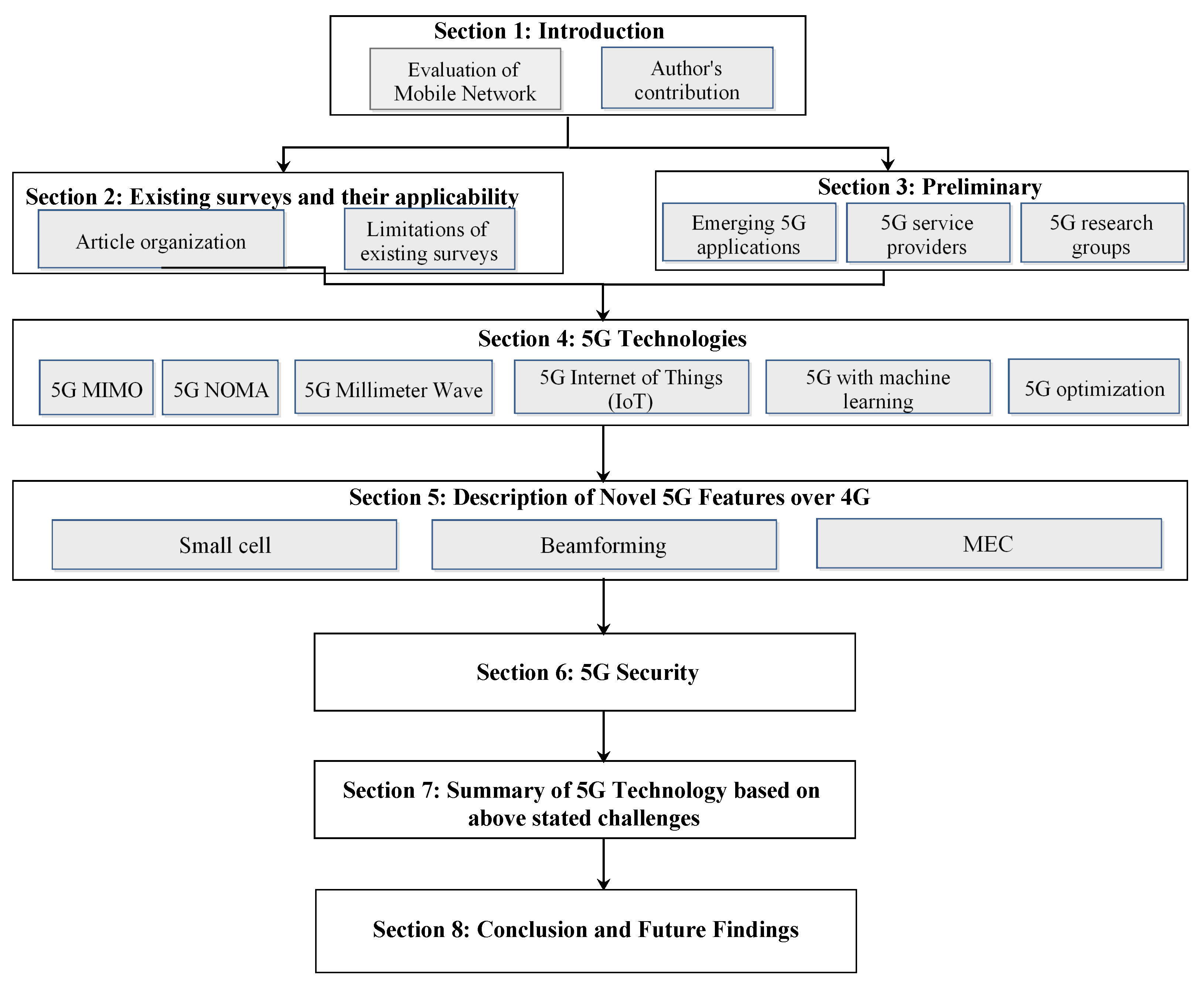
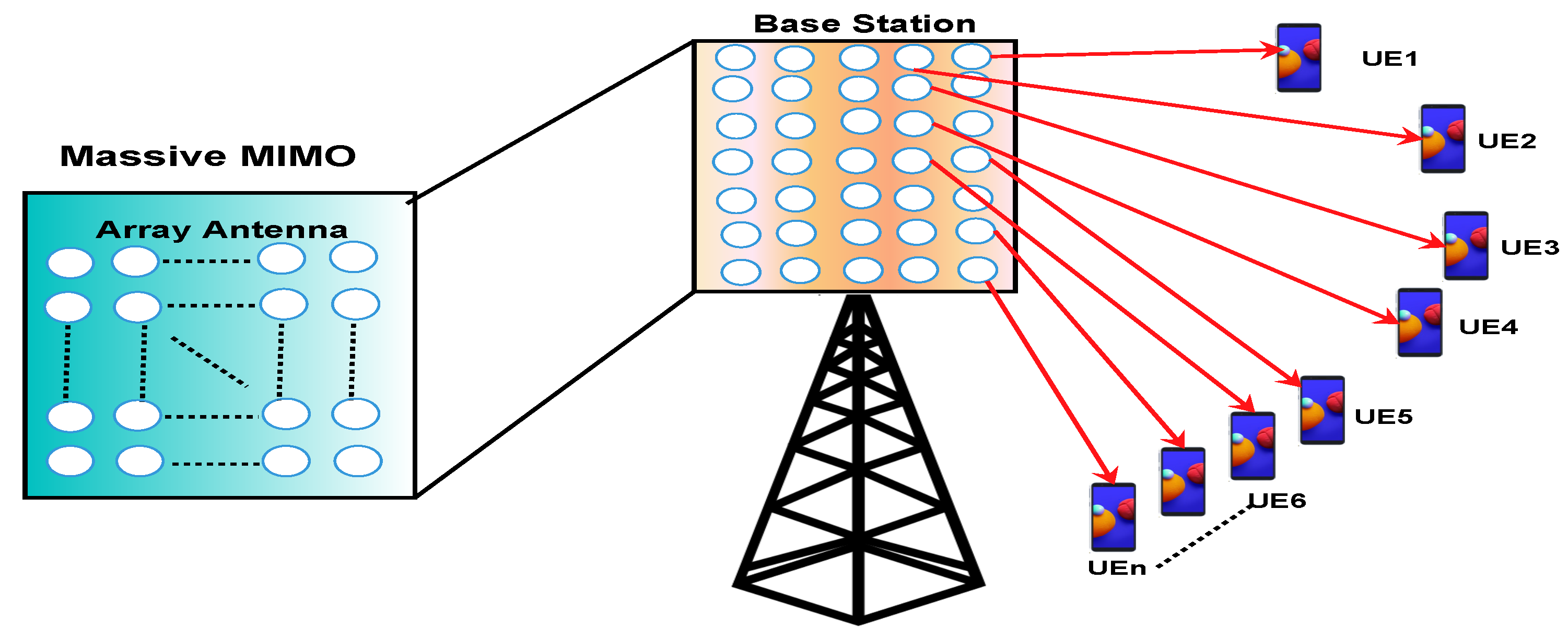
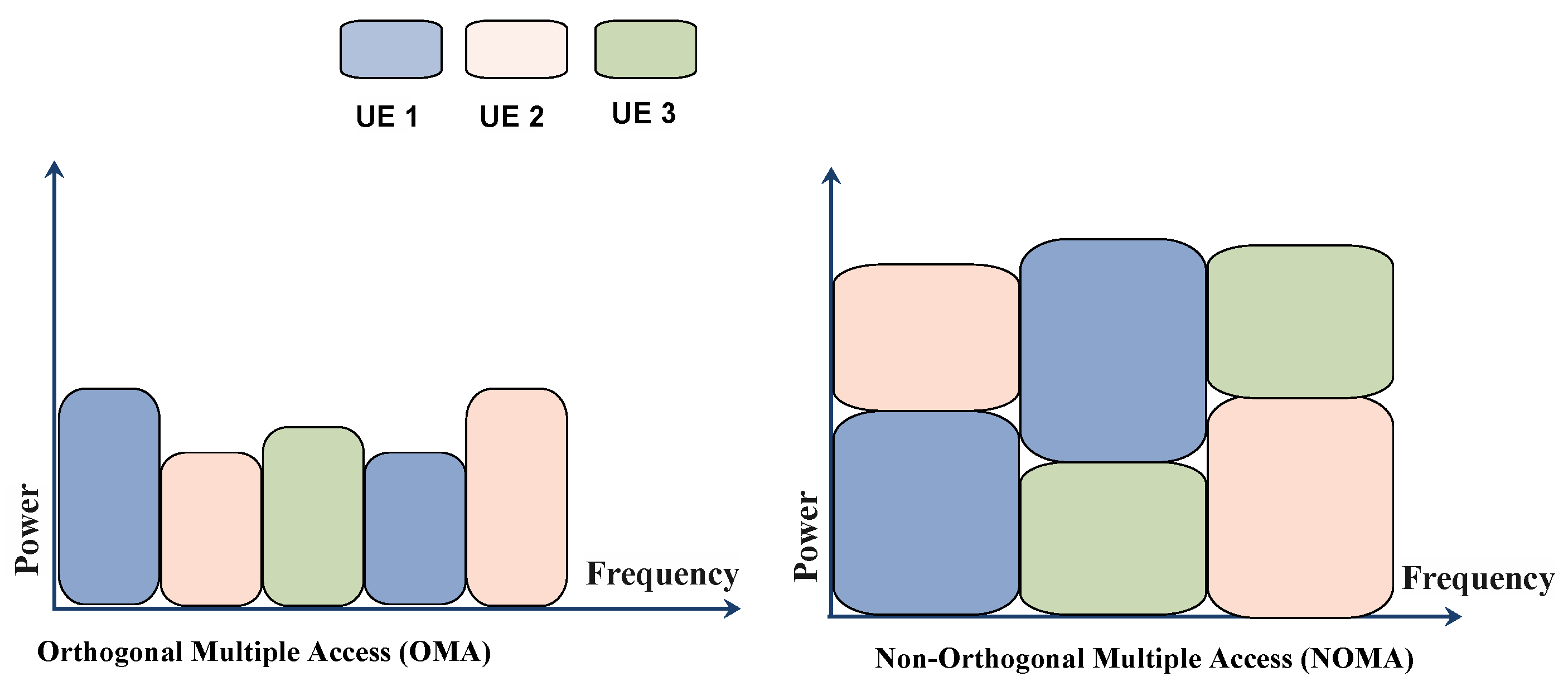
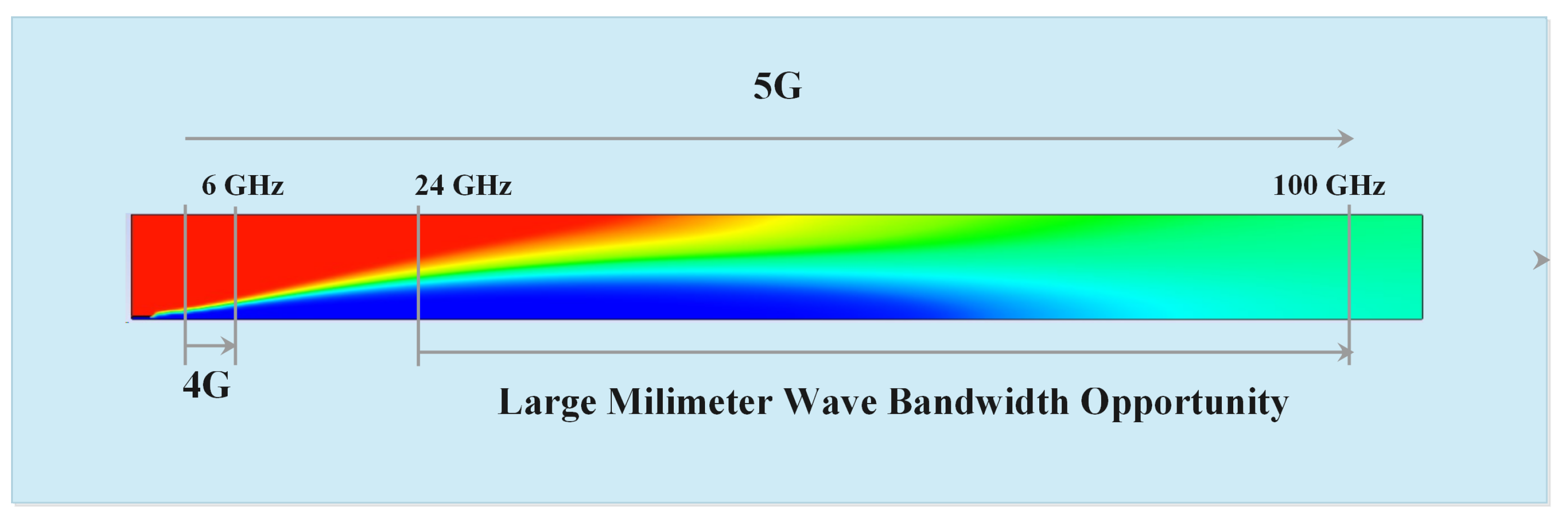
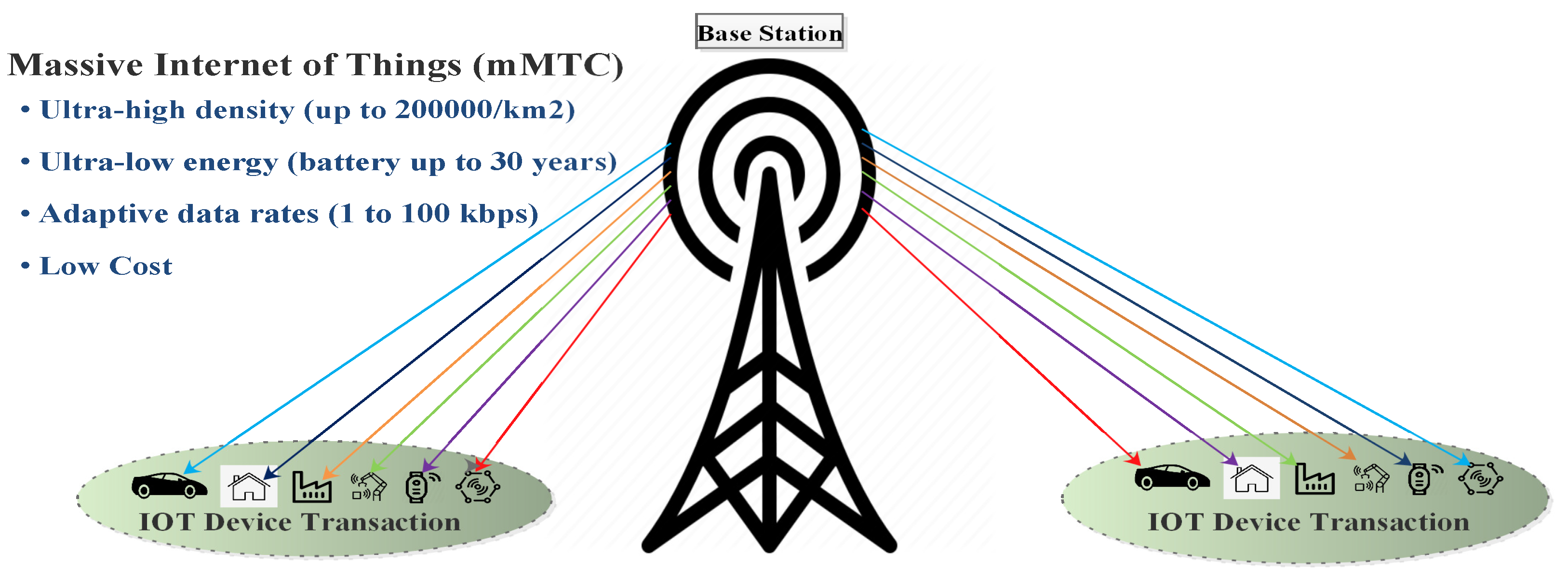
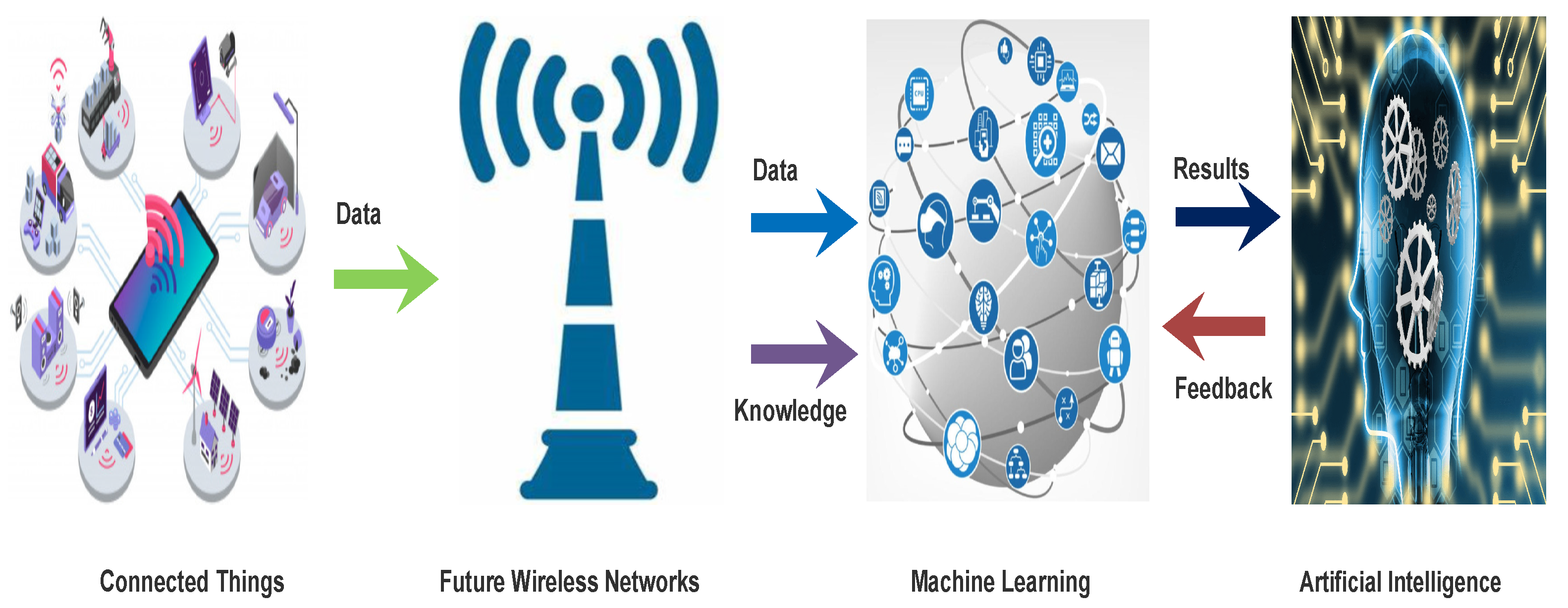
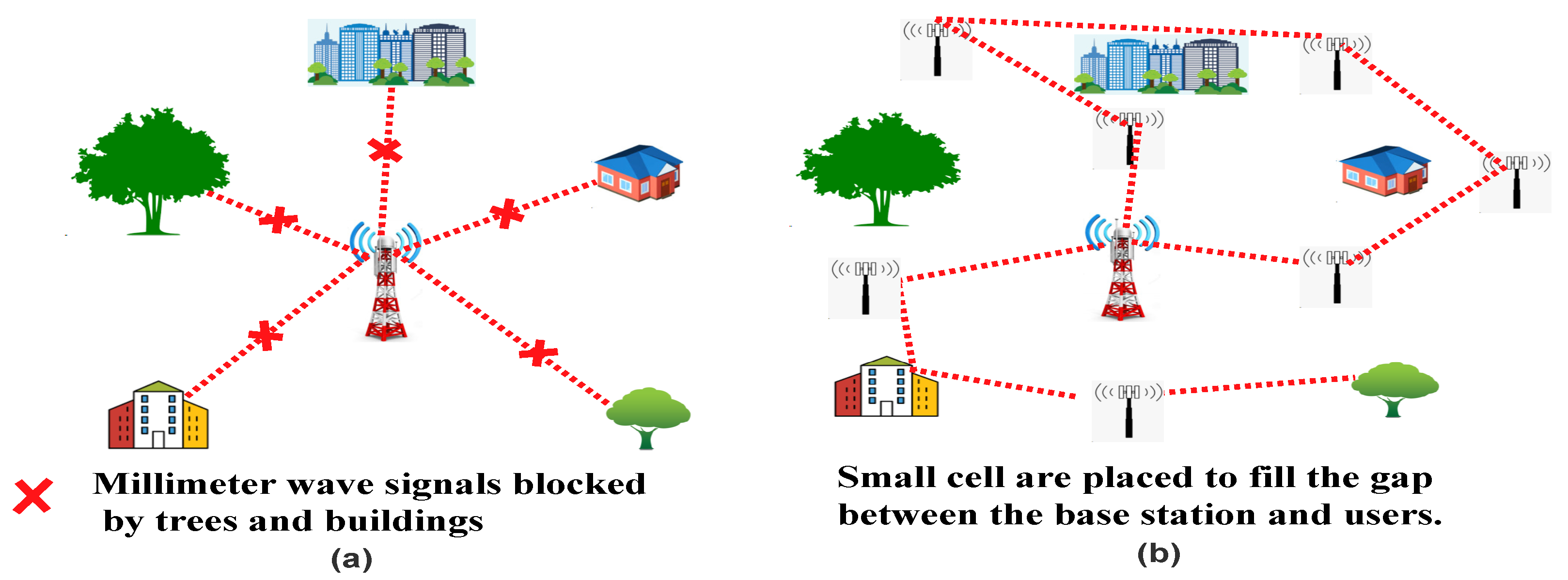
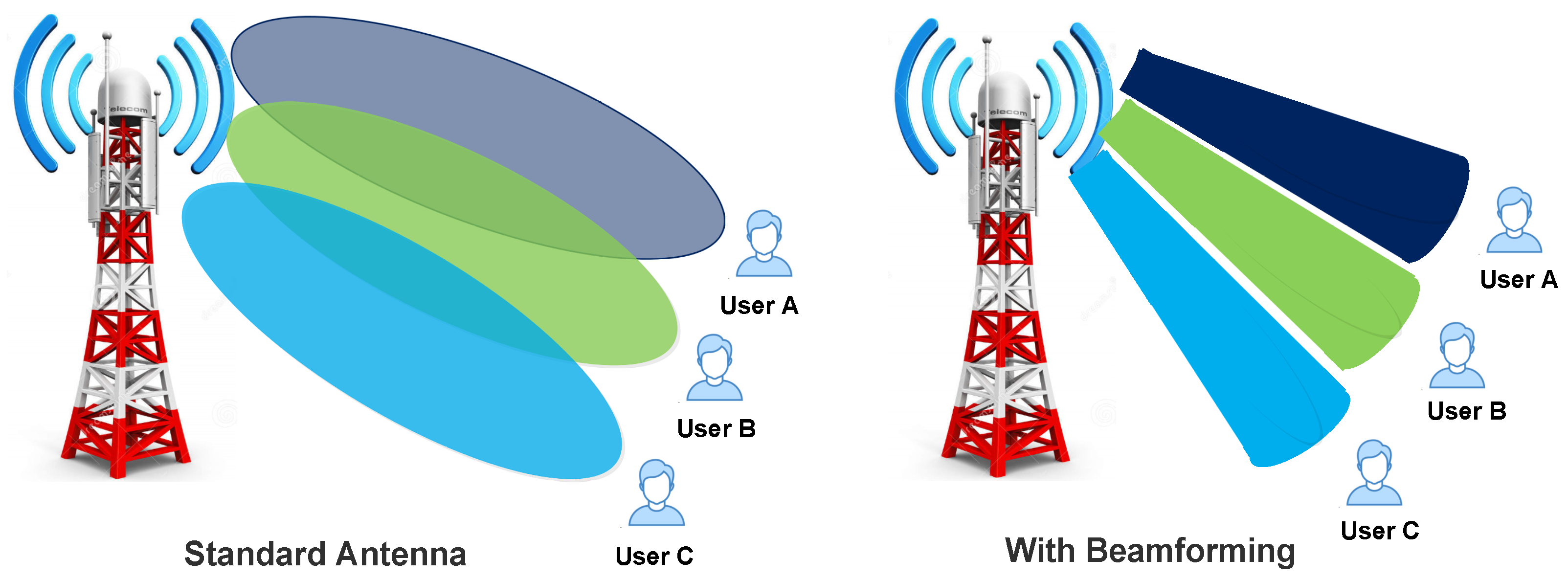
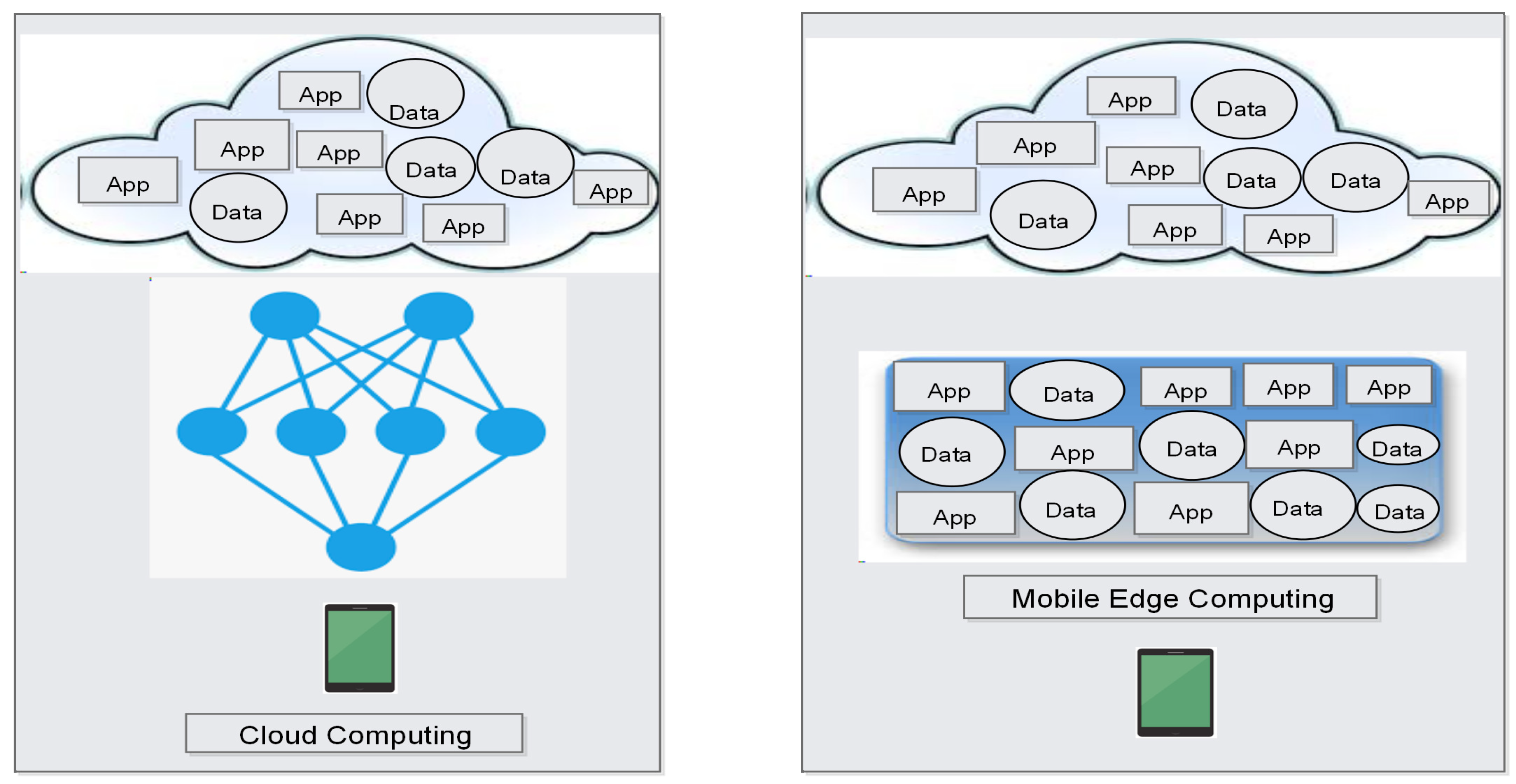
| Generations | Access Techniques | Transmission Techniques | Error Correction Mechanism | Data Rate | Frequency Band | Bandwidth | Application | Description |
|---|---|---|---|---|---|---|---|---|
| 1G | FDMA, AMPS | Circuit Switching | NA | 2.4 kbps | 800 MHz | Analog | Voice | Let us talk to each other |
| 2G | GSM, TDMA, CDMA | Circuit Switching | NA | 10 kbps | 800 MHz, 900 MHz, 1800 MHz, 1900 MHz | 25 MHz | Voice and Data | Let us send messages and travel with improved data services |
| 3G | WCDMA, UMTS, CDMA 2000, HSUPA/HSDPA | Circuit and Packet Switching | Turbo Codes | 384 kbps to 5 Mbps | 800 MHz, 850 MHz, 900 MHz, 1800 MHz, 1900 MHz, 2100 MHz | 25 MHz | Voice, Data, and Video Calling | Let us experience surfing internet and unleashing mobile applications |
| 4G | LTEA, OFDMA, SCFDMA, WIMAX | Packet switching | Turbo Codes | 100 Mbps to 200 Mbps | 2.3 GHz, 2.5 GHz and 3.5 GHz initially | 100 MHz | Voice, Data, Video Calling, HD Television, and Online Gaming. | Let’s share voice and data over fast broadband internet based on unified networks architectures and IP protocols |
| 5G | BDMA, NOMA, FBMC | Packet Switching | LDPC | 10 Gbps to 50 Gbps | 1.8 GHz, 2.6 GHz and 30–300 GHz | 30–300 GHz | Voice, Data, Video Calling, Ultra HD video, Virtual Reality applications | Expanded the broadband wireless services beyond mobile internet with IOT and V2X. |
| Abbreviation | Full Form | Abbreviation | Full Form |
|---|---|---|---|
| AMF | Access and Mobility Management Function | M2M | Machine-to-Machine |
| AT&T | American Telephone and Telegraph | mmWave | millimeter wave |
| BS | Base Station | NGMN | Next Generation Mobile Networks |
| CDMA | Code-Division Multiple Access | NOMA | Non-Orthogonal Multiple Access |
| CSI | Channel State Information | NFV | Network Functions Virtualization |
| D2D | Device to Device | OFDM | Orthogonal Frequency Division Multiplexing |
| EE | Energy Efficiency | OMA | Orthogonal Multiple Access |
| EMBB | Enhanced mobile broadband: | QoS | Quality of Service |
| ETSI | European Telecommunications Standards Institute | RNN | Recurrent Neural Network |
| eMTC | Massive Machine Type Communication | SDN | Software-Defined Networking |
| FDMA | Frequency Division Multiple Access | SC | Superposition Coding |
| FDD | Frequency Division Duplex | SIC | Successive Interference Cancellation |
| GSM | Global System for Mobile | TDMA | Time Division Multiple Access |
| HSPA | High Speed Packet Access | TDD | Time Division Duplex |
| IoT | Internet of Things | UE | User Equipment |
| IETF | Internet Engineering Task Force | URLLC | Ultra Reliable Low Latency Communication |
| LTE | Long-Term Evolution | UMTC | Universal Mobile Telecommunications System |
| ML | Machine Learning | V2V | Vehicle to Vehicle |
| MIMO | Multiple Input Multiple Output | V2X | Vehicle to Everything |
| Authors& References | MIMO | NOMA | MmWave | 5G IOT | 5G ML | Small Cell | Beamforming | MEC | 5G Optimization |
|---|---|---|---|---|---|---|---|---|---|
| Chataut and Akl [7] | Yes | - | Yes | - | - | - | Yes | - | - |
| Prasad et al. [8] | Yes | - | Yes | - | - | - | - | - | - |
| Kiani and Nsari [9] | - | Yes | - | - | - | - | - | Yes | - |
| Timotheou and Krikidis [10] | - | Yes | - | - | - | - | - | - | Yes |
| Yong Niu et al. [11] | - | - | Yes | - | - | Yes | - | - | - |
| Qiao et al. [12] | - | - | Yes | - | - | - | - | - | Yes |
| Ramesh et al. [13] | Yes | - | Yes | - | - | - | - | - | - |
| Khurpade et al. [14] | Yes | Yes | - | Yes | - | - | - | - | - |
| Bega et al. [15] | - | - | - | - | Yes | - | - | - | Yes |
| Abrol and jha [16] | - | - | - | - | - | Yes | - | - | Yes |
| Wei et al. [17] | - | Yes | - | - | - | - | - | - | |
| Jakob Hoydis et al. [18] | - | - | - | - | - | Yes | - | - | - |
| Papadopoulos et al. [19] | Yes | - | - | - | - | - | Yes | - | - |
| Shweta Rajoria et al. [20] | Yes | - | Yes | - | - | Yes | Yes | - | - |
| Demosthenes Vouyioukas [21] | Yes | - | - | - | - | - | Yes | - | - |
| Al-Imari et al. [22] | - | Yes | Yes | - | - | - | - | - | - |
| Michael Till Beck et al. [23] | - | - | - | - | - | - | Yes | - | |
| Shuo Wang et al. [24] | - | - | - | - | - | - | Yes | - | |
| Gupta and Jha [25] | Yes | - | - | - | - | Yes | - | Yes | - |
| Our Survey | Yes | Yes | Yes | Yes | Yes | Yes | Yes | Yes | Yes |
| Research Groups | Research Area | Description |
|---|---|---|
| METIS (Mobile and wireless communications Enablers for Twenty-twenty (2020) Information Society) | Working 5G Framework | METIS focused on RAN architecture and designed an air interface which evaluates data rates on peak hours, traffic load per region, traffic volume per user and actual client data rates. They have generate METIS published an article on February, 2015 in which they developed RAN architecture with simulation results. They design an air interface which evaluates data rates on peak hours, traffic load per region, traffic volume per user and actual client data rates.They have generate very less RAN latency under 1ms. They also introduced diverse RAN model and traffic flow in different situation like malls, offices, colleges and stadiums. |
| 5G PPP (5G Infrastructure Public Private Partnership) | Next generation mobile network communication, high speed Connectivity. | Fifth generation infrastructure public partnership project is a joint startup by two groups (European Commission and European ICT industry). 5G-PPP will provide various standards architectures, solutions and technologies for next generation mobile network in coming decade. The main motto behind 5G-PPP is that, through this project, European Commission wants to give their contribution in smart cities, e-health, intelligent transport, education, entertainment, and media. |
| 5GNOW (5th Generation Non-Orthogonal Waveforms for asynchronous signaling) | Non-orthogonal Multiple Access | 5GNOW’s is working on modulation and multiplexing techniques for next generation network. 5GNOW’s offers ultra-high reliability and ultra-low latency communication with visible waveform for 5G. 5GNOW’s also worked on acquiring time and frequency plane information of a signal using short term Fourier transform (STFT) |
| EMPhAtiC (Enhanced Multicarrier Technology for Professional Ad-Hoc and Cell-Based Communications) | MIMO Transmission | EMPhAtiC is working on MIMO transmission to develop a secure communication techniques with asynchronicity based on flexible filter bank and multihop. Recently they also launched MIMO based trans-receiver technique under frequency selective channels for Filter Bank Multi-Carrier (FBMC) |
| NEWCOM (Network of Excellence in Wireless Communications) | Advanced aspects of wireless communications | NEWCOM is working on energy efficiency, channel efficiency, multihop communication in wireless communication. Recently, they are working on cloud RAN, mobile broadband, local and distributed antenna techniques and multi-hop communication for 5G network. Finally, in their final research they give on result that QAM modulation schema, system bandwidth and resource block is used to process the base band. |
| NYU New York University Wireless | Millimeter Wave | NYU Wireless is research center working on wireless communication, sensors, networking and devices. In their recent research, NYU focuses on developing smaller and lighter antennas with directional beamforming to provide reliable wireless communication. |
| 5GIC 5G Innovation Centre | Decreasing network costs, Preallocation of resources according to user’s need, point-to-point communication, Highspeed connectivity. | 5GIC, is a UK’s research group, which is working on high-speed wireless communication. In their recent research they got 1Tbps speed in point-to-point wireless communication. Their main focus is on developing ultra-low latency app services. |
| ETRI (Electronics and Telecommunication Research Institute) | Device-to-device communication, MHN protocol stack | ETRI (Electronics and Telecommunication Research Institute), is a research group of Korea, which is focusing on improving the reliability of 5G network, device-to-device communication and MHN protocol stack. |
| Approach | Throughput | Latency | Energy Efficiency | Spectral Efficiency |
|---|---|---|---|---|
| Panzner et al. [47] | Good | Low | Good | Average |
| He et al. [48] | Average | Low | Average | - |
| Prasad et al. [8] | Good | - | Good | Avearge |
| Papadopoulos et al. [19] | Good | Low | Average | Avearge |
| Ramesh et al. [13] | Good | Average | Good | Good |
| Zhou et al. [51] | Average | - | Good | Average |
| Approach | Spectral Efficiency | Fairness | Computing Capacity |
|---|---|---|---|
| Al-Imari et al. [22] | Good | Good | Average |
| Islam et al. [53] | Good | Average | Average |
| Kiani and Nsari [9] | Average | Good | Good |
| Timotheou and Krikidis [10] | Good | Good | Average |
| Wei et al. [17] | Good | Average | Good |
| Approach | Transmission Rate | Coverage | Cost |
|---|---|---|---|
| Hong et al. [61] | Average | Average | Low |
| Qiao et al. [12] | Average | Good | Average |
| Wei et al. [62] | Good | Average | Low |
| Approach | Data Rate | Security Requirement | Performance |
|---|---|---|---|
| Akpakwu et al. [65] | Good | Average | Good |
| Khurpade et al. [14] | Average | - | Average |
| Ni et al. [66] | Good | Average | Average |
| Author References | Key Contribution | ML Applied | Network Participants Component | 5G Network Application Parameter | |||||
|---|---|---|---|---|---|---|---|---|---|
| RAN | Core | LB | SDN | RAN | RA | SEC | |||
| Alave et al. [68] | Network traffic prediction | LSTM and DNN | ✓ | ✓ | * | ✓ | ✓ | ✓ | X |
| Bega et al. [15] | Network slice admission control algorithm | Machine Learning and Deep Learing | ✓ | X | X | ✓ | ✓ | ✓ | X |
| Suomalainen et al. [69] | 5G Security | Machine Learning | X | ✓ | ✓ | ✓ | ✓ | ✓ | ✓ |
| Bashir et al. [70] | Resource Allocation | Machine Learning | ✓ | ✓ | ✓ | ✓ | ✓ | ✓ | X |
| Balevi et al. [71] | Low Latency communication | Unsupervised clustering | X | ✓ | X | ✓ | ✓ | ✓ | X |
| Tayyaba et al. [72] | Resource Management | LSTM, CNN, and DNN | ✓ | ✓ | X | ✓ | ✓ | ✓ | ✓ |
| Sim et al. [73] | 5G mmWave Vehicular communication | FML (Fast machine Learning) | X | ✓ | * | ✓ | ✓ | ✓ | X |
| Li et al. [74] | Intrusion Detection System | Machine Learning | X | ✓ | X | ✓ | ✓ | ✓ | ✓ |
| Kafle et al. [75] | 5G Network Slicing | Machine Learning | X | ✓ | X | ✓ | ✓ | ✓ | ✓ |
| Chen et al. [76] | Physical-Layer Channel Authentication | Machine Learning | X | ✓ | X | X | X | X | ✓ |
| Sevgican et al. [77] | Intelligent Network Data Analytics Function in 5G | Machine Learning | ✓ | X | ✓ | X | X | * | * |
| Abidi et al. [78] | Optimal 5G network slicing | Machine Learning and Deep Learing | X | ✓ | X | ✓ | ✓ | ✓ | * |
| Approach | Energy Efficiency | Quality of Services (QoS) | Latency |
|---|---|---|---|
| Fang et al. [79] | Good | Good | Average |
| Alawe et al. [68] | Good | Average | Low |
| Bega et al. [15] | - | Good | Average |
| Approach | Energy Efficiency | Power Optimization | Latency |
|---|---|---|---|
| Zi et al. [80] | Good | - | Average |
| Abrol and jha [16] | Good | Good | - |
| Pérez-Romero et al. [81] | - | Average | Average |
| Lähetkangas et al. [82] | Average | - | Low |
| Types of Small Cell | Coverage Radius | Indoor Outdoor | Transmit Power | Number of Users | Backhaul Type | Cost |
|---|---|---|---|---|---|---|
| Femtocells | 30–165 ft 10–50 m | Indoor | 100 mW 20 dBm | 8–16 | Wired, fiber | Low |
| Picocells | 330–820 ft 100–250 m | Indoor Outdoor | 250 mW 24 dBm | 32–64 | Wired, fiber | Low |
| Microcells | 1600–8000 ft 500–250 m | Outdoor | 2000–500 mW 32–37 dBm | 200 | Wired, fiber, Microwave | Medium |
| Approach | R1 | R2 | R3 | R4 | R5 | R6 | R7 | R8 | R9 | R10 | R11 | R12 | R13 | R14 |
|---|---|---|---|---|---|---|---|---|---|---|---|---|---|---|
| Panzner et al. [47] | Good | Low | Good | - | Avg | - | - | - | - | - | - | - | - | - |
| Qiao et al. [12] | - | - | - | - | - | - | - | Avg | Good | Avg | - | - | - | - |
| He et al. [48] | Avg | Low | Avg | - | - | - | - | - | - | - | - | - | - | - |
| Abrol and jha [16] | - | - | Good | - | - | - | - | - | - | - | - | - | - | Good |
| Al-Imari et al. [22] | - | - | - | - | Good | Good | Avg | - | - | - | - | - | - | - |
| Papadopoulos et al. [19] | Good | Low | Avg | - | Avg | - | - | - | - | - | - | - | - | - |
| Kiani and Nsari [9] | - | - | - | - | Avg | Good | Good | - | - | - | - | - | - | - |
| Beck [23] | - | Low | - | - | - | - | - | Avg | - | - | - | Good | - | Avg |
| Ni et al. [66] | - | - | - | Good | - | - | - | - | - | - | Avg | Avg | - | - |
| Elijah [50] | Avg | Low | Avg | - | - | - | - | - | - | - | - | - | - | - |
| Alawe et al. [68] | - | Low | Good | - | - | - | - | - | - | - | - | - | Avg | - |
| Zhou et al. [51] | Avg | - | Good | - | Avg | - | - | - | - | - | - | - | - | - |
| Islam et al. [53] | - | - | - | - | Good | Avg | Avg | - | - | - | - | - | - | - |
| Bega et al. [15] | - | Avg | - | - | - | - | - | - | - | - | - | - | Good | - |
| Akpakwu et al. [65] | - | - | - | Good | - | - | - | - | - | - | Avg | Good | - | - |
| Wei et al. [17] | - | - | - | - | - | - | - | Good | Avg | Low | - | - | - | - |
| Khurpade et al. [14] | - | - | - | Avg | - | - | - | - | - | - | - | Avg | - | - |
| Timotheou and Krikidis [10] | - | - | - | - | Good | Good | Avg | - | - | - | - | - | - | - |
| Wang [45] | Avg | Low | Avg | Avg | - | - | - | - | - | - | - | - | - | - |
| Akhil Gupta & R. K. Jha [25] | - | - | Good | Avg | Good | - | - | - | - | - | - | Good | Good | - |
| Pérez-Romero et al. [81] | - | - | Avg | - | - | - | - | - | - | - | - | - | - | Avg |
| Pi [59] | - | - | - | - | - | - | - | Good | Good | Avg | - | - | - | - |
| Zi et al. [80] | - | Avg | Good | - | - | - | - | - | - | - | - | - | - | - |
| Chin [101] | - | - | Good | Avg | - | - | - | - | - | Avg | - | Good | - | - |
| Mamta Agiwal [5] | - | Avg | - | Good | - | - | - | - | - | - | Good | Avg | - | - |
| Ramesh et al. [13] | Good | Avg | Good | - | Good | - | - | - | - | - | - | - | - | - |
| Niu [11] | - | - | - | - | - | - | - | Good | Avg | Avg | - | - | - | |
| Fang et al. [79] | - | Avg | Good | - | - | - | - | - | - | - | - | - | Good | - |
| Hoydis [18] | - | - | Good | - | Good | - | - | - | - | Avg | - | Good | - | - |
| Wei et al. [62] | - | - | - | - | Good | Avg | Good | - | - | - | - | - | - | - |
| Hong et al. [61] | - | - | - | - | - | - | - | - | Avg | Avg | Low | - | - | - |
| Rashid [102] | - | - | - | Good | - | - | - | Good | - | - | - | Avg | - | Good |
| Prasad et al. [8] | Good | - | Good | - | Avg | - | - | - | - | - | - | - | - | - |
| Lähetkangas et al. [82] | - | Low | Av | - | - | - | - | - | - | - | - | - | - | - |
Publisher’s Note: MDPI stays neutral with regard to jurisdictional claims in published maps and institutional affiliations. |
© 2021 by the authors. Licensee MDPI, Basel, Switzerland. This article is an open access article distributed under the terms and conditions of the Creative Commons Attribution (CC BY) license (https://creativecommons.org/licenses/by/4.0/).
Share and Cite
Dangi, R.; Lalwani, P.; Choudhary, G.; You, I.; Pau, G. Study and Investigation on 5G Technology: A Systematic Review. Sensors 2022, 22, 26. https://doi.org/10.3390/s22010026
Dangi R, Lalwani P, Choudhary G, You I, Pau G. Study and Investigation on 5G Technology: A Systematic Review. Sensors. 2022; 22(1):26. https://doi.org/10.3390/s22010026
Chicago/Turabian StyleDangi, Ramraj, Praveen Lalwani, Gaurav Choudhary, Ilsun You, and Giovanni Pau. 2022. "Study and Investigation on 5G Technology: A Systematic Review" Sensors 22, no. 1: 26. https://doi.org/10.3390/s22010026
APA StyleDangi, R., Lalwani, P., Choudhary, G., You, I., & Pau, G. (2022). Study and Investigation on 5G Technology: A Systematic Review. Sensors, 22(1), 26. https://doi.org/10.3390/s22010026









